Introduction
The integration of Android applications into smart farming has revolutionized the agricultural landscape, empowering farmers and agricultural experts with advanced software tools to refine farming techniques and amplify overall efficiency. Designed to deliver real-time information on critical factors like soil quality, weather patterns, and crop development, these applications enable informed decision-making and optimization of agricultural activities. The increasing popularity of smart farming apps is evident in the projected market size, with the global intelligent farming market anticipated to reach USD 13.5 billion by 2023, exhibiting a noteworthy CAGR of 13.8% 1.
Utilizing sensors and devices, smart farming apps gather crucial data on crop growth, weather conditions, and soil quality, leading to significant improvements in farming methodologies. The integration of Android applications into smart farming has transformed agriculture, equipping farmers and experts with advanced tools to refine techniques and boost efficiency. For instance, in grapevine irrigation, the implementation of smart farming practices resulted in a remarkable 28% increase in grape yield compared to conventional methods 3. This tangible example showcases the practical benefits of smart farming apps in enhancing crop yields.
Moreover, research indicates that adopting smart farming technology has the potential to increase crop yields by up to 30%, while concurrently reducing water and fertilizer consumption 2. These statistics highlight the real-world impact of technology on agricultural productivity.
Beyond enhancing crop yields, these apps empower farmers with tools to analyse market trends intelligently, contributing to increased profit margins 4. Key functionalities of smart farming Android apps include data collection through sensors, weather monitoring, crop management, and market analysis. By delivering real-time data and automated recommendations, these applications enable farmers to enhance productivity, reduce costs, and achieve higher yields.
As environmental concerns grow, the significance of smart farming technology in agriculture is expected to rise, shaping the future of sustainable farming practices. Numerous studies underscore the positive impact of smart farming Android apps on agriculture and crop yields, making them indispensable tools for modern farmers seeking to navigate the dynamic landscape of the agricultural sector.
Literature Review
Numerous studies have delved into the development of informative and guideline-oriented mobile applications tailored for farmers, incorporating sensor monitoring and control functionalities. These applications serve as comprehensive tools, offering insights into cultivation practices, farming tools, equipment, and valuable search advice. The potential of smartphones in agriculture has been scrutinized, as highlighted in 5, which explores various agricultural applications, presenting a case study of a transformative agricultural system mobile app leveraging interactive sensor technology. The study meticulously examines app design and technology to provide farmers with a promising solution for accessing government information and fostering community engagement.
One noteworthy example is the “Cotton App,” discussed in 6, which stands out as a trustworthy resource for real-time, site-specific information. Operating on both iOS and Android platforms, this app significantly streamlines user interactions by reducing feedback when accessing databases via a server. Another technological advancement, the smartphone-based LoRa Wizard, as outlined in 7, specializes in measuring soil propagation. The study rigorously tests LoRa technology for soil dissemination and its potential in providing agricultural support.
The focus on water conservation and irrigation is evident in 8, introducing the “EVAPO” Android app. This innovative application estimates evapotranspiration in real time, utilizing weather data and the Penman–Monteith process. Validation involves comparing the app’s estimated evapotranspiration with meteorological station data to determine its effectiveness. Furthermore, 9 introduces an Android app designed to accurately and swiftly count rice and wheat grains, boasting a mere 2% error rate and one-second counting time.
Apps like those discussed in 10, 12 play a pivotal role in assisting farmers in crop selection based on factors such as water supply, temperature, soil pH, location, and crop duration. These applications, designed to be simple, affordable, and customized, include notable examples like the “Cotton Smart Irrigation” App and “Smart Sensor” developed by the University of Georgia, as compared in 11.
The realm of smartphone-based agricultural monitoring is explored in 13, where 3G/LTE connectivity and microcontroller-connected sensors are deployed to monitor water, fertilizers, and various farm parameters. The data collected is then analyzed through internet-connected microcontrollers. Additionally, 14 introduces an offline Android app aimed at aiding maize farmers in “Malaybalay City, Bukidnon,” with a focus on increasing crop yields and grain production. The app’s development follows the modified waterfall model.
Research projects like 15 delve into remote monitoring and field spray control mobile apps, developed for both Android and iOS platforms. The “Padi2U” app, detailed in 16, offers a wealth of information ranging from paddy variety and planting timetables to drone pictures, diseases, pests, weeds, weather forecasts, and farmers’ reports. In a bid to empower farmers with direct access to agricultural information, 17 introduces an informative Android app, eliminating the need for intermediaries or SMS responses from web portals.”Agro-Sense,” explored in 18, utilizes Android and Arduino-based systems to monitor farm parameters such as light, temperature, humidity, and moisture. The app efficiently displays remote monitoring data for enhanced decision-making. Additionally, 19 presents an Android app linking farmers to the food industry and retailers.
The innovative integration of an Android app and Arduino-based system for controlling cultivation water supply is presented in 20. This system incorporates sensors to measure soil moisture and temperature, with the app receiving SMS notifications. Noteworthy is the app’s capability to capture soil images for soil type detection. A suite of mobile apps, as outlined in 21, forecasts and prevents pesticide use for various crops. These applications offer farm control and monitoring functionalities without requiring additional hardware.
In conclusion, the collective impact of these smart farming Android apps is poised to significantly enhance crop yields, refine farming practices, and contribute to sustainability in the agricultural sector. The widespread adoption of these technological solutions is anticipated to propel the agricultural industry forward, embracing the transformative potential of smart farming technologies.
Materials and Methodology
The KisanVishwa mobile application stands as a comprehensive solution meticulously tailored to meet the distinctive requirements of the Indian agricultural landscape. With a paramount focus on user-friendliness, the application is crafted to be effortlessly navigated, catering to individuals with limited technical proficiency commonly found in the agricultural community. Compatibility-wise, the application is optimized for Android devices boasting API level 23, ensuring seamless functionality across a wide range of devices, including those with lower memory capacities and slower network speeds. This deliberate optimization strategy enhances accessibility, making the app inclusive for farmers with varying technological resources.
The core features of KisanVishwa extend beyond basic functionalities, delving into critical monitoring and management tools for crop variables. An intelligent notification system has been integrated to alert farmers about potential threats, including the risk of animal encroachment. This proactive approach empowers farmers with timely information to mitigate risks and safeguard their crops effectively.
A distinctive attribute of KisanVishwa is its role as a comprehensive agricultural ecosystem. The application serves as a central hub for identifying vendors, intermediaries, and suppliers of essential agricultural resources. This encompasses a wide array of offerings, including agricultural machinery, implements, and agrochemicals. Moreover, KisanVishwa doesn’t stop at being a marketplace; it goes the extra mile by providing valuable farming recommendations tailored to diverse cultivars. This multifaceted functionality positions the application as an indispensable tool for farmers, offering not just a marketplace but a knowledge center to enhance agricultural practices.
The user-centric design of KisanVishwa caters to two distinct user groups within the agricultural spectrum. On one front, it accommodates individuals who have embraced precision agriculture infrastructure and IoT-enabled hardware. For this tech-savvy group, the application seamlessly integrates with existing technologies, enhancing their precision farming practices. On the other end, KisanVishwa recognizes the diverse landscape of Indian agriculture, acknowledging those who have not yet adopted advanced technologies. The application serves as a bridge, providing a user-friendly entry point for those looking to step into precision agriculture, making it an inclusive platform for all farmers.
In addition to its existing features, KisanVishwa envisions expansion and continuous improvement. Future updates could include advanced analytics for crop management, real-time weather integration for more precise decision-making, and collaborative features to foster knowledge-sharing within the farming community. The scalability and adaptability of KisanVishwa position it as a dynamic tool that evolves in tandem with the changing needs and technological advancements in Indian agriculture. A simplified design and development flow for the KisanVishwa Android app is presented below.
Requirement Analysis:
Understand and document the requirements for the app, focusing on both IoT and non-IoT functionalities.
User Stories and Use Cases
Create user stories and use cases to capture different scenarios for users with and without IoT hardware.
Design Wireframes
Develop wireframes to visualize the app’s user interface, ensuring it is user-friendly and optimized for Android devices.
Compatibility Planning
Plan for compatibility across a range of Android devices, specifically targeting API level 23 and optimizing for lower memory capacities and slower network speeds.
Cloud Service Selection
Choose a suitable cloud service for data storage and visualization, ensuring reliability and scalability.
Frontend Development
Develop the frontend of the app, including UI components for features accessible without IoT hardware.
Backend Development
Implement the backend functionality, focusing on cloud integration and storage for data visualization. Develop features that require IoT hardware.
Security Implementation
Implement security measures for user data, especially for features involving data storage and remote control.
Testing
Conduct thorough testing, including unit testing, integration testing, and device testing for compatibility. Test both without and with IoT hardware functionalities.
User Feedback and Iteration
Collect feedback from users during testing phases and iterate on the design based on their input.
Documentation
Create comprehensive documentation for the development team, including architecture, data flow diagrams, and APIs.
Deployment
Deploy the app to the Google Play Store, ensuring it meets the necessary guidelines and requirements.
Post-Deployment Support
Provide ongoing support, addressing user feedback, fixing bugs, and planning for future updates.
Scalability and Future Updates
Plan for scalability and outline a strategy for future updates, considering advanced analytics, real-time weather integration, and collaborative features.
This flow provides a general guideline for the Android app design and development process. Additional steps or modifications may be necessary based on project-specific requirements and complexities.
Results and Findings
Features accessible without IoT hardware.
The KisanVishwa application serves as an invaluable repository of information, offering users access to a diverse range of agricultural technologies and insights into the challenges tied to crop growth, as illustrated in Figure 1. This universal accessibility ensures that every user of the system is equipped with the essential knowledge required for informed decision-making in agricultural practices.
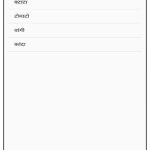 |
Figure 1: Page for Guideline Information of Cultivating different corps |
The main page of the KisanVishwa application, showcased in Figure 2, is thoughtfully designed in Marathi, the regional language of Maharashtra. This strategic localization enhances comprehension and usability for users who prefer or are more comfortable communicating in Marathi.
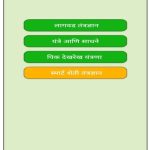 |
Figure 2: Kisan Vishwa main Page |
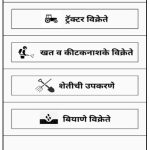 |
Figure 3: Sub-menu centralised page. |
The app incorporates valuable advice on agricultural practices sourced from Krishi Vigyan Kendra (KVK) – agricultural research and knowledge canters. This feature not only provides technical assistance but also establishes links for users to access government policies and initiatives in agrarian economies.
Figure 3 encapsulaste all discussed solutions, providing users with a centralized page for easy reference. This ensures a seamless experience for users seeking information on agricultural practices, dealers, and other pertinent solutions. To ensure farmers have access to top-tier inputs, the app includes a dedicated section featuring names, addresses, and phone numbers of retailers specializing in crop-specific seeds, fertilizers, pesticides, and other agricultural supplies. This function assists users in pinpointing suitable dealers based on their current geographic location.
To configure app in Real-time required sensor based hardware to be in syncronisation and configuration, visualization, and Control: KisanVishwa’s integrated cloud infrastructure gives hardware users real-time control over farm parameters. The AWS EC2 cloud architecture is scalable and portable. Apps features are shown in Figure 5. Real-time Farm Control: With precision agriculture hardware in the field, users can remotely control actuators and collect field data through the app. The smart control page let farmers control actuators via the cloud. Data Visualization of Farm Field Parameters: The app displays real-time data and its fluctuations for different constraints. The results page that was developed within the app and is displayed in Figure 4 provides information about the cultivation of crops as well as the essential conditions that are specific to each crop. which would be of great assistance to farmers if they knew the precise constraints that are required fo r a particular crop.
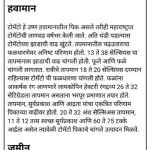 |
Figure 4: Information about crop. |
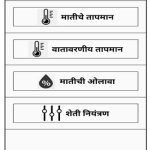 |
Figure 5: Control view of Precision farming with hardware |
Figure 6 illustrates the functionality of the “KishanVishwa” Android app that allows users to search for farming tools and equipment based on their location. This results page, which was developed within the app, enables users to search for and explore a variety of farming tools and equipment that is tailored to their particular location in a convenient and hassle-free manner.
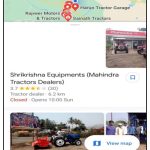 |
Figure 6: Results of search of farming tools and equipment based on users location |
By implementing precision agriculture hardware in the field, farmers can remotely control various actuators and collect data from the field through the app. Figure 7 illustrates the page that enables the control of various farm parameters. Through the app, farmers can send controlling commands via the cloud to effectively manage and control the actuators.
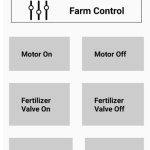 |
Figure 7: Figure 7 Farm Control View of Kisan Vishwa |
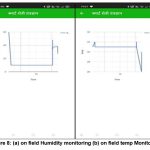 |
Figure 8: (a) on field Humidity monitoring (b) on field temp Monitoring. |
The application displays data in real time and visualizes how it varies over time in response to a variety of constraints. Figure 8 (a) and (b) provide users with a graphical representation of the on-field temperature and humidity in the app, allowing users to monitor and analyse these extremely important parameters.
Conclusion
the “KishanVishwa” Android app stands as a versatile solution, catering to both precision agriculture hardware users and traditional farming practices. Through its integration with Krishi Vignyan Kendra (KVK), the app ensures universal access to crucial information and expert guidance, fostering unity among farmers.
For precision agriculture users, real-time control and data visualization capabilities enhance operational efficiency. The app’s user-friendly design in Marathi promotes inclusivity, reflecting a commitment to accessibility. In the future, the app can be enriched by integrating an AI-enabled chatbot to provide advanced technical assistance and address inquiries from farmers. An option for feedback and suggestions can be incorporated into the application, allowing users to share their experiences and provide valuable input.
In essence, “KishanVishwa” empowers farmers with tools and technology, facilitating informed decisions and contributing to agricultural progress. Its diverse functionalities make it a transformative force, driving positive change in the farming landscape.
Acknowledgement
The author would like to thank Mr. Nikhil Kamble for providing support in android app development.
Funding Sources
The author(s) received no specific funding for this work.
Conflict of Interest
The author(s) has(have) no conflict of interest to declare.
Data Availability Statement
This statement does not apply to this article.
Ethics Approval Statement
This research study does not involve experiments on humans or animals. Therefore, ethics approval from a relevant authorizing body is not applicable.
Authors’ Contribution
Arun Patokar:
Conceived and designed the research study as part of his Ph.D. work.
Conducted all the development and implementation efforts.
Generated and analyzed the experimental data.
Drafted the initial manuscript.
Dr. Vinaya Gohokar
Served as the supervisor throughout the research process.
Provided guidance and expertise in formulating the research objectives.
Contributed to the critical review and refinement of the manuscript.
Offered insights and suggestions for improving the methodology and analysis.
References
- singh H, Kumar R, Mehara A Markets and markets. Smart Farming Market by Agriculture Type (Precision Farming, Livestock Monitoring, Fish Farming, Smart Greenhouse), Hardware (GPS, Drones, Sensors, RFID, LED Grow Lights), Software, Services, Application, and Geography – Global Forecast to 2023. Retrieved from https://www.marketsandmarkets.com/Market-Reports/smart-farming-market-522.html 2023,43-46.
- Nwakwasi, R. N., Ogunyemi, S. K., Oyeleke, M. O., Ogunyemi, O. A., & Adebo, G. M.. Precision Agriculture: An Overview of Smart Farming Technologies. Agricultural Research & Technology: Open Access Journal, 2019 22(1).
- García L, Parra L, Jimenez JM, Lloret J, Lorenz P. IoT-Based Smart Irrigation Systems: An Overview on the Recent Trends on Sensors and IoT Systems for Irrigation in Precision Agriculture. Sensors. 2020;20(4):1042.
CrossRef - Kowalski, A., Kowalski, K Adoption of Smart Farming Technologies and Their Impact on Agricultural Production and Farm Income. Sustainability, 2021 13(5), 2915.
- Karetsos S, Costopoulou C, Sideridis A. Developing a smartphone app for m-government in agriculture. Journal of Agricultural Informatics. 2014;5(1).
CrossRef - Vellidis G, Liakos V, Andreis JH, et al. Development and assessment of a smartphone application for irrigation scheduling in cotton. Computers and Electronics in Agriculture. 2016; 127:249-259.
CrossRef - Xue-fen W, Xing-jing D, Yi Y, Jing-wen Z, Sardar MS, Jian C. Smartphone based LoRa in-soil propagation measurement for wireless underground sensor networks. 2017 IEEE Conference on Antenna Measurements & Applications (CAMA). Published online December 2017.
CrossRef - Maldonado W, Valeriano TTB, de Souza Rolim G. EVAPO: A smartphone application to estimate potential evapotranspiration using cloud gridded meteorological data from NASA-POWER system. Computers and Electronics in Agriculture. 2019;156:187-192.
CrossRef - Liu T, Chen W, Wang Y, et al. Rice and wheat grain counting method and software development based on Android system. Computers and Electronics in Agriculture. 2017; 141:302-309.
CrossRef - Koli, R. P., & Jadhav, V. D. Agriculture Decision Support System As Android Application. International Journal of Science and Research (IJSR) 2013, 4(4) 903-906
- Vellidis, G., Liakos, V., Perry, C., Tucker, M., Collins, G., Snider, J., Barnes, E.. A smartphone app for scheduling irrigation on cotton. Proceedings of the Beltwide Cotton Conference, 2018.
- Wadje, S., Gadakh, M., Sangamnere, A., & Tungar, G. Smart Farming System Android App. International Research Journal of Engineering and Technology(IRJET).2017. 4(4),1949-1951
- Chaitanya, K. S., Ilayarajaa, K. T., Karthikeyan, & Teja Reddy, K. M. Android based iot for agriculture automation. International Journal of Pure and Applied Mathematics.2017 117(21) 169-176
- Aribe, S. G., Turtosa, J. M. H., Yamba, J. M. B., & Jamisola, A. B. (2019). Ma-ease: An android-based technology for corn production and management. Pertanika Journal of Science and Technology. 2019,27(1):49-68
- Caner Koc, Abdulkadir Guneytepe, Bulent Perktas, Izem Aykanat. Development of a mobile app for remote monitoring and control of a pull type field sprayer. Kansas City, Missouri, 2013. 2(2).
CrossRef - Athirah, R. N., Norasma, C. Y. N., & Ismail, M. R. (2020). Development of an Android Application for Smart Farming in Crop Management. IOP Conference Series: Earth and Environmental Science. 2020;540(1):012074.
CrossRef - Ghanshyam, K., Pooja, K., Pooja, N., & Yogita, G. AGRONOMY-An Android Application Regarding Farmer Utility. Journal of Emerging Technologies and Innovative Research (JETIR).2016 3(4) 86-89.
- K. D. Yesugade, Sonal Bathiya, Priya Bora, & Nikita Waykule. Agro-Sense: A Mobile App for Efficient Farming System using Sensors. International Journal of Engineering Research & Technology 2015 4(4) 456-459
CrossRef - Shriram, P., & Mhamane, S. (2018). Android App to Connect Farmers to Retailers and Food Processing Industry. In Proceedings of the 3rd International Conference on Inventive Computation Technologies, ICICT 2018 284-287
CrossRef - Ramadoss, P. ABHINAYALALITHA, K. Arduino Based Agricultural Monitoring System in Mobile Application. International Research Journal of Engineering and Technology(IRJET).2017 4(5) 786-791
- Vennila, S., Tomar, A., Bhatt, M. N., Murari, K., Yadav, S. K., Nisar, S., Yadav, H. L. Android based mobile apps for improved crop protection. Bhartiya Krishi Anusandhan Patrika. 2018;33(4)
CrossRef

